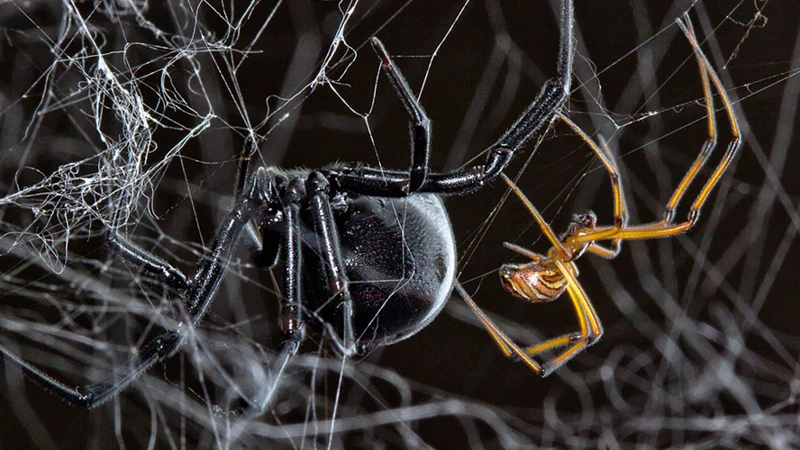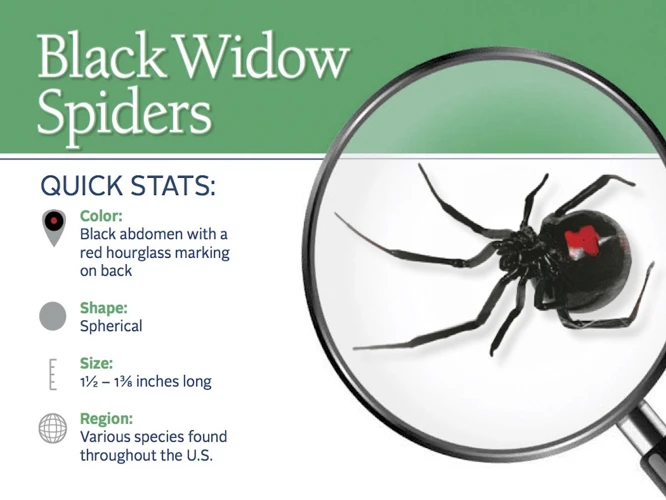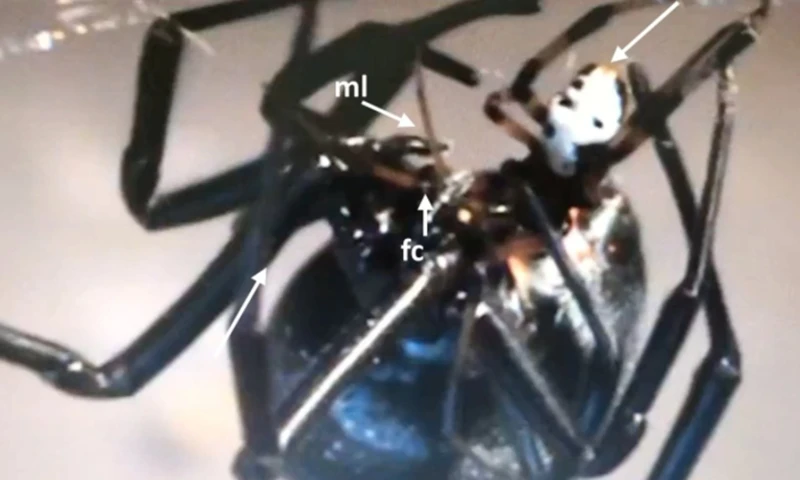As we delve into the fascinating world of black widow spiders, we cannot help but ponder over the curious behavior of female black widows, who seem to mate with multiple partners. Why exactly do they do this? And what are the costs and benefits of practicing polyandry in these spiders? In this article, we will explore the intricacies of multiple mating in female black widow spiders, and uncover the potential advantages and drawbacks of this practice. From reproduction to survival and behavioral strategies, let us embark on a journey of discovery and unravel the mysteries of these enigmatic arachnids.
Reproduction

Reproduction is a vital aspect of the life cycle of Black Widow Spiders. The female Black Widow Spider has shown incredible mating strategies to ensure the survival and genetic diversity of her offspring. However, this process is not risk-free and has the potential cost of reduced offspring size. The mate selection process, including mating plugs and sperm competition, also plays a prominent role in the reproductive success of these spiders. Let’s explore the benefits and potential costs of multiple mating for female Black Widow Spiders. As we delve deeper into this topic, we will also discover the role that factors such as resource availability, environmental factors, male sacrifice, female aggression, male ornaments and sexual selection play in Black Widow Spider mating.
Increase in Offspring Survival
Multiple mating has several benefits for female black widow spiders. One of the most important benefits to females is an increase in offspring survival. By mating with multiple males, females can increase their chances of producing offspring with healthier genes.
Here are some ways that multiple mating can increase offspring survival:
- Combining the genes of different males can result in offspring with a wider range of traits, making them better able to adapt to changes in their environment.
- Females can also use the sperm from multiple males to selectively fertilize their eggs, giving each offspring the best chance for survival.
- Mating with multiple males can also increase the genetic diversity of a female’s offspring, making them less susceptible to disease and parasites.
In some cases, multiple mating can also reduce the risk of inbreeding and subsequent genetic abnormalities in offspring. However, there is also a potential cost to reduced offspring size, which can occur if the female has to divide her limited energy resources among multiple offspring.
Understanding the benefits and costs of multiple mating can help researchers better understand the behavior of female black widow spiders, and how they have evolved over time through sexual selection and environmental pressures. To learn more about the mating behaviors of black widow spiders, check out our article on sexual selection in these fascinating creatures.
Increased Genetic Diversity in Offspring
Increased genetic diversity is another benefit of multiple mating for female black widow spiders. By mating with multiple males, females are able to produce offspring that have a wider variety of genetic material. This can result in increased hybrid vigor, where the offspring exhibit greater fitness than their parents.
Genetic diversity can also increase the likelihood of adaptation to changing environmental conditions, such as changes in temperature or the presence of new predators or prey. This ability to adapt can be crucial for the survival of a species in the long term.
Multiple mating can reduce the risk of inbreeding, which can have negative effects on offspring fitness. Inbreeding can increase the likelihood of genetic disorders and decrease immunity to disease.
By seeking multiple mates, female black widow spiders can increase their chances of producing genetically diverse and healthy offspring that are better adapted to their environment.
It is important to note, however, that increased genetic diversity is not the only determining factor in the success of offspring survival. Factors such as resource availability and the environment can also play a significant role in determining the fate of offspring. Additionally, there are potential costs associated with multiple mating, such as the risk of disease and parasites.
Potential Cost of Reduced Offspring Size
When female black widow spiders engage in multiple mating, there is a potential cost of reduced offspring size, which is worth analyzing. While multiple mating increases the genetic diversity of the offspring and survival rates, it could also lead to smaller offspring, a disadvantage for the next generation of spiders. In some cases, the loss of offspring size could impact their survival and turn to be not advantageous behavior.
There are different factors why multiple mating could lead to smaller offspring. One of them is the sperm competition, which occurs when multiple males mate with a single female in a short period. This process usually results in males producing smaller sperm to increase their chances for fertilization, leading to smaller offspring. Another factor could be the depletion of the female’s resources such as nutrients, energy, and other essential elements required for egg development. As she takes more males, females become depleted, and eggs may be smaller as a result.
A study by Daniel R. Formanowicz Jr. and Maydianne C.B. Andrade found that female black widows who mated with multiple males produced smaller offspring compared to females who mated with only one male. The size of the offspring was a significant predictor of its survival. The smaller the offspring, the higher the chance it would die before reaching adulthood. There’s always a trade-off between the advantages of multiple mating and the potential cost of smaller offspring size.
Table showing Pros and Cons of Multiple Mating for Female Black Widow Spiders
| Benefits | Costs |
|---|---|
| Increase in offspring survival | Reduced offspring size |
| Increased genetic diversity in offspring | Increased risk of disease and parasites |
| Increased protection from predators |
While multiple mating can bring several advantages, it’s necessary to take into account the potential costs associated with it, such as reduced offspring size and increased risk of disease and parasites. It’s essential to understand more about the environmental factors, resource availability, and other factors that may impact the mating behavior of black widow spiders. But, there’s always the question of why black widow spiders behave in certain ways. Some possible answers are male ornaments as a part of female mate choice, female aggression, environmental factors, or even the function of male sacrifice in black widow mating.
Survival

Survival Strategies of Female Black Widow Spiders
Female black widow spiders mate with multiple males to enhance their reproductive success. However, the benefits of multiple mating go beyond just reproduction. By considering the costs and benefits of multiple mating, female black widow spiders can enhance their survival chances in the harsh and competitive environment where they live. In this section, we will explore how multiple mating can boost the survival chances of female black widow spiders and how it can also pose certain risks. Additionally, we will also uncover the behavioral strategies that female black widows use to optimize the outcomes of multiple matings. In this context, considering factors such as resource availability, environmental factors, courtship, male sacrifice, female aggression, and sperm competition becomes necessary. Let’s dive in and explore these fascinating survival strategies of female black widow spiders.
Increased Protection from Predators
Increased protection from predators is one of the benefits of multiple mating for female black widow spiders. By engaging in multiple matings, they are able to obtain more mating plugs that provide a physical barrier to prevent other males from mating with them. This increased protection allows them to focus on other activities such as foraging, web building and taking care of their offspring.
By mating with multiple males, females get a chance to choose a high-quality mate who may possess traits that give offspring an advantage in dealing with predators. In many cases, males that are visually attractive or possess behavioral traits such as aggression or sacrifice to provide nutrition for females and their offspring, may increase the survival of their offspring.
However, there is a potential cost where multiple mating may also increase the risk of predation since female black widows, after mating, are less able to hide or defend themselves from predators. Predators may also be attracted to the pheromones produced during mating. Multiple matings require more energy expenditure and time, making females more vulnerable to predation.
This understanding of increased protection from predators is crucial for understanding the mating strategies of black widow spiders. By balancing these costs and benefits, black widow females can make better decisions in choosing their mates based on the environmental factors, resource availability, male ornaments, and their life stage.
Internal link: More information about female aggression during black widow spider mating can be found in the article on female aggression during mating.
Potential Cost of Increased Risk of Disease and Parasites
While multiple mating can offer advantages for female black widow spiders in terms of offspring survival and genetic diversity, there are also potential costs. One such cost is the increased risk of disease and parasites that can come with multiple mating partners.
Here are some potential negative effects of increased risk of disease and parasites:
- Male black widow spiders may carry pathogens or parasites that could be transmitted to the female during mating.
- If a female mates with multiple males, she may increase her exposure to harmful pathogens and parasites.
- Over time, this could negatively impact the health and overall survival of the female spider, as well as her offspring.
It’s important to note that there are other factors that can impact the risks of disease and parasites for female black widows during mating. For example, the availability of resources in the environment, the behavioral strategies of male and female spiders during courtship, and the potential benefits and risks of cannibalism during mating all play a role in shaping this complex phenomenon. Understanding these factors is crucial for gaining a deeper insight into the fascinating world of black widow spider mating.
To learn more about the different factors that can influence black widow spider mating behavior, you can check out our articles on male ornaments and female mate choice, courtship, and cannibalism. Additionally, you can explore the ways in which environmental factors impact black widow mating in our article on resource availability and other relevant aspects.
Behavioral Strategies
When it comes to the mating habits of black widow spiders, the females have developed a variety of behavioral strategies to ensure successful reproduction. These strategies involve everything from selecting preferred mates to facilitating sperm competition. Let’s explore some of the fascinating ways that female black widow spiders behave in order to ensure the survival of their offspring. We’ll also examine the potential costs and benefits of these reproductive strategies. To gain a more complete understanding of black widow spider mating, it’s worth considering the evolutionary history of this species, as well as the impact of factors like resource availability and male sacrifice.
Mating Preferences and Selection
Multiple mating in female black widow spiders presents a unique opportunity to examine the mate selection and preference of these animals. Interestingly, females have been found to have a choice in the males with whom they mate. They prefer males who are larger and have a brighter red coloration on their abdomen. This may indicate that these traits serve as indicators of overall health and genetic quality. The table below summarizes the effects of mate preferences and selection in female black widow spiders.
| Effect of Mate Preferences and Selection | Description |
|---|---|
| Increased Fitness of Offspring | Females who mate with more attractive and healthy males have offspring with increased survival and genetic diversity, leading to greater fitness of the offspring. |
| Decreased Fitness of Males | Males who are not as physically fit or attractive may be rejected as mates by females, decreasing their fitness and reducing their chances of passing on their genes. |
| Costs of Female Choosiness | Females who spend too much time and energy selecting mates may miss out on other important resources, such as food and shelter, which can negatively impact their overall fitness. |
It’s worth mentioning that there are many factors that can influence mate selection in black widow spiders, including the availability of resources, the risk of predation, and the behavior of potential mates. Additionally, males of some species may engage in “male sacrifice” or other behaviors to increase their chances of mating. For more information on this topic, check out our article on male sacrifice in black widow mating.
Mating Plugs and Sperm Competition
Male black widow spiders are known for their short life spans, which often end shortly after they have mated. However, female black widow spiders have developed a unique strategy to maximize the benefits of multiple mating. One of these strategies is the use of mating plugs and sperm competition.
After mating, a male black widow spider will deposit a mating plug into the female genital opening. This plug serves to physically block the entrance to the female reproductive tract, preventing other males from mating with her and increasing the chances of his own sperm fertilizing her eggs.
However, this strategy is not always successful. Research has shown that in some cases, the female can remove the mating plug and mate with another male. This leads to sperm competition, where the sperm of multiple males compete for fertilization of the eggs.
Sperm competition can ultimately lead to increased genetic diversity in the offspring, as well as increased chances of survival. However, it can also come with potential costs such as reduced offspring size.
Mating plugs and sperm competition are important factors in the reproductive strategies of female black widow spiders. They serve to maximize the benefits of multiple mating, but also come with potential costs. To learn more about other factors that influence black widow spider mating behavior, check out our article on black widow spider mating and life history traits.
Conclusion
After analyzing the costs and benefits of multiple mating for female black widow spiders, it is clear that the advantages outweigh the disadvantages when it comes to reproduction and survival. The increased offspring survival rate and genetic diversity far outweighs the potential cost of reduced offspring size. Additionally, multiple mating offers female black widows with increased protection from predators, overcoming the potential risk of disease and parasites.
It is also worth noting that behavior plays a significant role in the mating strategies of female black widows. Preference and selection play a significant role in determining which males a female will mate with, while mating plugs and sperm competition help ensure that the most genetically superior offspring are produced.
While resource availability and other factors can determine whether or not a female black widow will engage in multiple matings, it is important to note that the evolution of these behaviors has been shaped by millions of years of natural selection. As such, the benefits of multiple mating for female black widow spiders are an important aspect of their biology that should continue to be explored and studied.
In conclusion, while there are some potential costs associated with multiple mating for female black widow spiders, the benefits of reproduction and survival far outweigh them. Through careful observation and study, we can continue to learn more about these fascinating creatures and how they have evolved to survive and thrive in their environments.
Frequently Asked Questions
What is multiple mating?
Multiple mating refers to the act of a female mating with multiple males during a single reproductive season.
Why do female black widow spiders engage in multiple mating?
Female black widow spiders engage in multiple mating to increase their chances of reproductive success and to produce more viable offspring.
What benefits do female black widow spiders gain from multiple mating?
Female black widow spiders gain increased offspring survival, increased genetic diversity in their offspring, and increased protection from predators through multiple mating.
Can multiple mating have potential costs for female black widow spiders?
Yes, multiple mating can have potential costs for female black widow spiders, such as reduced offspring size and increased risk of disease and parasites.
How does multiple mating increase offspring survival?
Multiple mating increases offspring survival by providing offspring with a greater genetic diversity, making them more adaptable to their environment and less susceptible to genetic disorders.
What is the potential cost of reduced offspring size?
The potential cost of reduced offspring size is that smaller offspring may be less likely to survive and reproduce, leading to a decrease in overall reproductive success.
How does multiple mating increase protection from predators?
Multiple mating increases protection from predators by providing female spiders with access to a wider range of potential mates, allowing them to select mates with greater physical or behavioral traits that may deter predators.
What is sperm competition?
Sperm competition is a form of sexual selection where multiple males compete for access to fertilize a female’s eggs, often resulting in the production of more viable offspring.
What is a mating plug?
A mating plug is a substance produced by males that is deposited in the female’s reproductive tract after mating, which can prevent or limit the insemination by other males and increase the chances of their own offspring surviving.
How do mating preferences and selection impact multiple mating in female black widow spiders?
Mating preferences and selection can impact multiple mating in female black widow spiders by influencing the number and quality of mating partners, ultimately affecting the genetic diversity and viability of their offspring.







